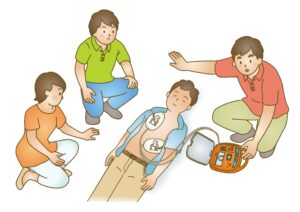Life Saving at its Best: Why Automated External Defibrillators (AEDs) Are Essential

In the realm of medical advancements, certain innovations stand out for their life-saving capabilities. Among these, the Automated External Defibrillator (AED) is a standout, known for its critical role in emergency cardiac care.
Understanding AEDs
Automated External Defibrillators are compact, portable devices crucial for responding to sudden cardiac arrest (SCA), a condition where the heart suddenly stops beating effectively. Designed for ease of use, AEDs come with voice prompts and simple instructions, making them accessible to both medical professionals and laypersons.
The Critical Role of AEDs
The importance of AEDs in emergency medical care is immense. Each year, sudden cardiac arrest affects hundreds of thousands of individuals globally, often outside the hospital. Without immediate intervention, the survival rate is dismally low. Here’s where AEDs come in, significantly improving the chances of survival when used promptly.
The device works by checking the heart’s rhythm and administering an electrical shock if needed to restore normal heart function. In the critical moments following a cardiac arrest, before emergency services arrive, an AED can be a lifesaver, literally.
AED Accessibility
For maximum impact, AEDs should be widely available in public spaces like schools, shopping centers, airports, and offices. For high-risk individuals, having an AED at home is equally important.
Maintaining Your AED
Owning an AED is a responsibility. It requires regular maintenance to ensure its functionality in an emergency.
- Routine Checks: Follow the manufacturer’s guidelines for maintenance and conduct regular inspections.
- Battery Life: The battery is the heart of the AED. Regularly check its life and have spare batteries ready. Typically, batteries may need replacing every 2 to 5 years.
- Electrode Pads: The adhesive pads are crucial for shock delivery. They have an expiration date and usually need replacement every 2 to 3 years.
- Readiness Indicator: Regularly check the AED’s operational status via its readiness indicator.
- Software Updates: Keep the AED’s software updated for optimal performance.
- Proper Storage: Store your AED in an easily accessible location and at room temperature to prevent damage.
Conclusion: A Call to Action
AEDs are a testament to how modern medicine can pivot the odds in favor of survival during cardiac emergencies. Their presence and proper maintenance can change the course of life-threatening situations, emphasizing the need for widespread awareness and accessibility of these devices. Whether you’re considering acquiring an AED or you already own one, remember its significance and ensure its maintained regularly. This commitment not only upholds the device’s integrity but also reinforces our readiness to save lives.
Shop AED Wall Mounted Sign, AED Training Practice Shields, AED Wall Mount.
